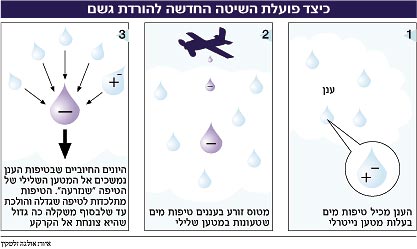Silver iodide precipitate/substitute
Yuval Dror, Haaretz, voila!

At the end of last week, the settlements in the north of the country received a considerable amount of rain, and still, every year, the Mekorot company looks to the sky and prays for rain. In order to "encourage" rain, various methods have been invented in recent years, including "cloud seeding" with silver iodide, but studies show that their effectiveness is low. Two physicists from the Hebrew University, Prof. Yuri Feldman and Prof. Alexander Chain, claim to have found an effective, cheap, simple and environmentally friendly method to cause recalcitrant raindrops trapped in the clouds to fall to the ground - charging them with an electric charge. The method also has a surprising bonus: it disperses fog in a matter of minutes.
Prof. Feldman, who became interested in meteorology several years ago, and Prof. Chain, who has been dealing with the physics of clouds for 30 years, found that the "trick" in making rain fall is to capture the tiny water droplets in the clouds into large drops. "From this stage, gravity does the rest," says Chain. The silver iodide causes the droplets to turn into ice crystals that grow in the clouds faster than the droplets, they explain, however, studies show that the silver iodide often does not bring the desired results and even causes soil pollution.
The method relies on the fact that the water drops in the cloud contain an equal number of positive and negative ions - a neutral electric charge. The two propose to seed the cloud with charged droplets, for example, with a negative charge. "When the 'negative droplets' approach the water droplets in the cloud, the positive ions in the drop are attracted to the negatively charged droplet and the droplets collide. The large droplet, which is formed by the coalescence of the droplets, remains charged with a negative charge. In a short time it keeps growing until one big drop is formed which eventually falls to the ground", explains Feldman. After implementing the method, they say, Israel will enjoy a 25% increase in the amount of water that falls over its basins. "Three planes that scatter charged drops can bring down a greater amount of water than the amount that Israel planned to bring from Turkey," says Chain. They reassure: "The drops that will fall on the ground will not electrify the people despite their electrical charge; The load is simply too small."
The method, they say, is also excellent for dispersing fog. "Fog is a collection of tiny droplets that do not coalesce," explains Chain. "When charged droplets are dispersed in fog, visibility increases from 30 meters to 230 meters in less than 30 minutes." To illustrate the theory, Feldman and Hain built a device made of a long glass tube into which they inserted an artificial fog. In the second step, the charged droplets were dispersed and measured in how long the fog turns into heavy droplets and disperses. Since fog exists in different and diverse places, the two looked for a simple way to activate the method that would be easily adapted to any place. "In Europe, landings and takeoffs are canceled time and time again due to fog," says Feldman. "At ski resorts, sometimes they wait a week for the fog to clear." A vehicle that carries a 30-meter high pipe and on top of it the device that disperses charged droplets, can disperse the fog in a short time, they explain. Through the Hebrew University's "Yishom" company, they are seeking to register a patent for the method they still refuse to disclose. "It is so simple that within days the Japanese may imitate it and then we will not be able to implement the idea", they say.
